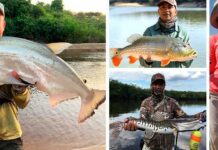The observation or sighting of pink dolphins is one of the most popular tourist activities in the eastern plains and the Colombian Amazon. These river dolphins represent a very attractive spectacle for nature lovers.
About the Pink River Dolphins or Toninas
The Matavén Jungle is made up of flood zones, savannahs in the middle of the jungle, rocky outcrops that reach up to 200 meters above sea level, more than 800 registered species, including plants, birds, fish and mammals.
Pink dolphins are endemic species of the Orinoquia and Amazon regions. They have characteristics that differentiate them from marine dolphins; Some of these characteristics are: that they have a less pronounced or in some cases non-existent dorsal fin and of course their pink color; It should be noted that not all of them are pink, some are usually gray and have only some pink on their body.
(Read Also: Tuparro National Natural Park; a paradise of exuberant natural beauty)
They usually swim in groups of approximately 25 specimens, generally stalking schools of fish to feed. Being endemic species to the Orinoco and Amazonia, they can only be observed in these regions; some reach lengths of up to 2.5 m.
Other names by which pink dolphins are known are: Bufeo, Bufeo colorado, Toninas and Boto.

Where can you see pink river dolphins or dolphins?
In Colombia, pink dolphins or dolphins can be observed in the Amazonas, Caquetá, Apaporis, Mirití Paraná, Cahuinarí, Putumayo, Meta, Guayabero, Vichada, Tomo, Guaviare, Orinoco, Bita and Arauca rivers, as well as several lakes.
They are generally easier to observe during low water, as they concentrate at or near river confluences on the main river.
Be sure to carry out this sighting activity in the company of authorized and professional service providers, this will guarantee you a better experience, and also make sure not to contaminate the environment of these beautiful animals with garbage or waste generated during your trip, you must take into account that the pink dolphin is an endangered species.
Recommendations for observing pink dolphins
- The vessels that carry out the sighting activity, once they are close to the animals, must maintain a course parallel to their movement, they must avoid closing the animals' escape routes.
- If more than one boat is near the animal, the boats must remain in parallel formation (side by side) without making a circle around the animals.
- When a boat is in the caution zone (between 50 and 25 meters from the dolphins), it may not exceed a maximum speed of five (5) knots. To leave the area, you may gradually increase speed up to ten (10) knots, once you leave this last area, you may reach normal navigation speed.
- Navigators should avoid heading towards areas where there are fixed fishing gears, to avoid entanglement of animals with boats.
- It is recommended to keep the boat's engine on during the sighting, so that the animals are aware of the location of the boats and thus avoid collisions.
- Approaching dolphins with calves, mating or giving birth should be avoided.
- Food should not be used to attract them.
- You should not make loud noises in or out of the water such as whistling, shouting, simulating crying or hitting the water.
- The sighting activity should not be extended in conditions of little natural light to avoid hitting any of the animals due to poor visibility.
- In general, it is recommended not to encourage tourists to swim with dolphins, since one should not forget that in the rivers there may be other species that could pose a danger such as anacondas, alligators, electric fish, as well as strong currents.
Recommendations to take the best photographs of pink dolphins or dolphins
- Try to take the photo with your back to the sun to avoid backlighting.
- Be sure to use the camera's maximum exposure speed. If you use semi or professional cameras, reduce the exposure by one or two stops to prevent the camera's reading on the water from causing the dolphins to be overexposed. It is also recommended to use speed priority to guarantee well-focused shots.
- If you have a compact camera, also try to look for the maximum speed. Some have a burst or sports function that fits the needs very well.
- It is essential to observe the surface of the water. With some patience you can see the waves of the animals as they move and predict when they will emerge so you can take the photo.
- The most comfortable boats for taking photographs are those without a roof.



